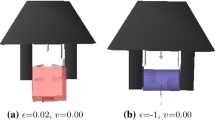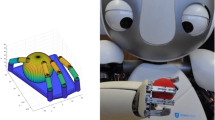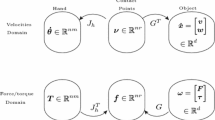Abstract
Acquiring a qualitative force-closure grasp requires the determination of feasible contact points on the object based on a defined criterion. The determination must be fast in order to implement feasible synthesis algorithms. Moreover, grasping of sheet metal parts has further requirements derived from its geometry and clamping tools. This paper presents a grasp quality analysis for the application of sheet metal parts. Moreover, a novel grasp quality measure approach is proposed based on standard deviation computation of the contact’s coordinates. The proposed measure is frame invariant, simple to implement, and has low computational complexity. A comparative analysis over other measures is presented. Further, a stress analysis was performed to show that the proposed criterion yields low stress on the sheet metal part compared to other criteria. Simulations show advantage to grasp synthesis with the proposed quality measure.














Similar content being viewed by others
References
Appleton, E., Arzanpour, S., Fung, J., Mills, J., & Cleghorn, W. (2006). Flexible fixture design with applications to assembly of sheet metal automotive body parts. Assembly Automation, 26(2), 143–153.
Borst, C., Fischer, M., & Hirzinger, G. (1999). A fast and robust grasp planner for arbitrary 3D objects. In Proceedings of the IEEE international conference on robotics and automation, (Vol. 3, pp. 1890–1896)
Cai, W., Hu, S., & Yuan, J. (1996). Deformable sheet metal fixturing: Principles, algorithms, and simulations. Journal of Manufacturing Science and Engineering, 118(3), 318–324.
Camelio, J. A., Hu, S. J., & Ceglarek, D. (2004). Impact of fixture design on sheet metal assembly variation. Journal of Manufacturing Systems, 23(3), 182–193.
Chinellato, E., Fisher, R., Morales, A., & del Pobil, A. (2003). Ranking planar grasp configurations for a three-finger hand. In Proceedings of the IEEE international conference on robotics and automation, (Vol. 1, pp. 1133–1138)
Ferrari, C., & Canny, J. (1992). Planning optimal grasps. In Proceedings of the IEEE international conference on robotics and automation, (pp. 2290–2295)
Gopalakrishnan, K., Goldberg, K., Bone, G., Zaluzec, M., Koganti, R., Pearson, R., et al. (2004). Unilateral fixtures for sheet-metal parts with holes. IEEE Transactions on Automation Science and Engineering, 1(2), 110–120.
Jolliffe, I. (2002). Principal component analysis. New York: Springer.
Kim, B. H., Yi, B. J., Oh, S. R., & Suh, I. H. (2004). Non-dimensionalized performance indices based optimal grasping for multi-fingered hands. Mechatronics, 14(3), 255–280.
Kirkpatrick, D., Mishra, B., & Yap, C. K. (1992). Quantitative Steinitz’s theorems with applications to multifingered grasping. Discrete & Computational Geometry, 7(1), 295–318.
Li, Z., & Sastry, S. (1987). Task oriented optimal grasping by multifingered robot hands. In Proceedings of the IEEE international conference on robotics and automation, (Vol. 4, pp. 389–394)
Lin, Q., Burdick, J. W., & Rimon, E. (2000). A stiffness-based quality measure for compliant grasps and fixtures. IEEE Transactions on Robotics and Automation, 16(6), 675–688.
Liu, Y. H. (2000). Computing n-finger form-closure grasps on polygonal objects. The International Journal of Robotics Research, 19(2), 149–158.
Miller, A., & Allen, P. (1999). Examples of 3D grasp quality computations. In Proceedings o the IEEE international conference on robotics and automation, (Vol. 2, pp. 1240–1246)
Mirtich, B., & Canny, J. (1994). Easily computable optimum grasps in 2-D and 3-D. In Proceedings of the IEEE international conference on robotics and automation, (pp. 739–747)
Mishra, B., Schwartz, J. T., & Sharir, M. (1987). On the existence and synthesis of multifinger positive grips. Algorithmica, 2, 541–558.
Murray, R. M., Li, Z., & Sastry, S. S. (1994). A mathematical introduction to robotic manipulation (1st ed.). Boca Raton: CRC Press.
Niparnan, N., & Sudsang, A. (2006). A heuristic approach for computing frictionless force-closure grasps of 2D objects from contact point set. In Proceedings of the IEEE conference on robotics, automation and mechatronics, (pp. 1–6)
Or, Y., & Rimon, E. (2006). Computation and graphical characterization of robust multiple-contact postures in two-dimensional gravitational environments. The International Journal of Robotics Research, 25(11), 1071–1086.
Or, Y., & Rimon, E. (2010). Analytic characterization of a class of three-contact frictional equilibrium postures in three-dimensional gravitational environments. The International Journal of Robotics Research, 29(1), 3–22.
Park, E. J., & Mills, J. K. (2002). Three-dimensional localization of thin-walled sheet metal parts for robotic assembly. Journal of Field Robotics, 19(5), 207–217.
Pearson, K. (1895). Note on regression and inheritance in the case of two parents. Proceedings of the Royal Society of London, 58, 240–242.
Pokorny, F., & Kragic, D. (2013). Classical grasp quality evaluation: New algorithms and theory. In Proceedings of the IEEE/RSJ international conference on intelligent robots and systems, (pp. 3493–3500)
Ponce, J., & Faverjon, B. (1995). On computing three-finger force-closure grasps of polygonal objects. IEEE Transactions on Robotics and Automation, 11(6), 868–881.
Preparata, F. P., & Shamos, M. I. (1985). Computational geometry. New York: Springer.
Roa, M., & Suarez, R. (2007). Geometrical approach for grasp synthesis on discretized 3d objects. In Proceedings of the IEEE/RSJ international conference on intelligent robots and systems, (pp. 3283–3288). IEEE
Roa, M., & Suarez, R. (2009). Regrasp planning in the grasp space using independent regions. In Proceedings of the IEEE/RSJ international conference on intelligent robots and systems, (pp. 1823–1829)
Roa, M., & Suarez, R. (2014). Grasp quality measures: Review and performance. Autonomous Robots, 38(1), 65–88.
Sahbani, A., El-Khoury, S., & Bidaud, P. (2012). An overview of 3D object grasp synthesis algorithms. Robotics and Autonomous Systems, 60(3), 326–336.
Seo, J., Kim, S., & Kumar, V. (2012). Planar, bimanual, whole-arm grasping. In Proceedings of the IEEE international conference on robotics and automation (ICRA), (pp. 3271–3277)
Sintov, A., Menassa, R. J., & Shapiro, A. (2014). OCOG: A common grasp computation algorithm for a set of planar objects. Robotics and Computer-Integrated Manufacturing, 30(2), 124–141.
Stewart, G. W. (1993). On the early history of the singular value decomposition. SIAM Review, 35(4), 551–566.
Supuk, T., Kodek, T., & Bajd, T. (2005). Estimation of hand preshaping during human grasping. Medical Engineering & Physics, 27(9), 790–797.
Ying, L., Fu, J., & Pollard, N. (2007). Data-driven grasp synthesis using shape matching and task-based pruning. IEEE Transactions on Visualization and Computer Graphics, 13(4), 732–747.
Author information
Authors and Affiliations
Corresponding author
Appendix
Appendix
The appendix contains proofs of the results stated in Sect. 4.
Lemma 1
Given two sets \(\mathcal {P}_1=\left\{ \mathbf {a}_{\mathbf{1}},\ldots ,\mathbf {a}_{\mathbf{n}}\right\} \) and \(\mathcal {P}_2=\left\{ \mathbf {b}_{\mathbf{1}},\ldots ,\mathbf {b}_{\mathbf{n}}\right\} \), where there exists a rotation matrix \(R\in SO(3)\) such that \(\mathbf {b}_{\mathbf{k}}=R\cdot \mathbf {a}_{\mathbf{k}}\) for all \(k=1,\ldots ,n\). The rotation matrices \(R_{SD}^{\mathbf {a}}\) and \(R_{SD}^{\mathbf {b}}\) are computed by the PCA function such that \(\mathbf {a}_{\mathbf{k}}'=R_{SD}^{\mathbf {a}}\mathbf {a}_{\mathbf{k}}\) and \(\mathbf {b}_{\mathbf{k}}'=R_{SD}^{\mathbf {b}}\mathbf {b}_{\mathbf{k}}\). By that, the respected vectors are equal; that is, \(\mathbf {a}_{\mathbf{k}}'=\mathbf {b}_{\mathbf{k}}'\) for all \(k=1,\ldots ,n\).
Proof
We define the mean vector of \(\mathcal {P}_1\) to be
By definition, there exists a rotation matrix R such that \(\mathbf {b}_{\mathbf{k}}=R\cdot \mathbf {a}_{\mathbf{k}}\) for all \(k=1,\ldots ,n\). Therefore, the mean vector of \(\mathcal {P}_2\) with respect to \(\bar{\mathbf{a}}\) is shown to be
Let \(\mathbf {a}\) and \(\mathbf {B}\) be matrices concatenating the vectors in \(\mathcal {P}_1\) and \(\mathcal {P}_2\), respectively, such that

and

The covariance matrices of \(\mathcal {P}_1\) and \(\mathcal {P}_2\) are given by
and
respectively. Applying (29) and (31) on (33) yields
According to (32) we acquire the relation between both covariance matrices to be
Next, the eigenvalues \(\lambda _{\mathbf {a}_i},~i=1,2,3\) of \(M_{\mathbf {a}}\) are the solution of
Similarly, the eigenvalues \(\lambda _{\mathbf {B}_i},~i=1,2,3\) of \(M_{\mathbf {b}}\) are the solution of
Equivalently, from (35), the left hand side of (37) can be written as
By definition, matrix R is an orthogonal matrix such that \(det(R)=det(R^T)=1\) and therefore
From (36) and (39) we can conclude that the eigenvalues of \(M_{\mathbf {a}}\) and \(M_{\mathbf {b}}\) are equal. That is,
To find the rotation matrices \(R_{SD}^{\mathbf {a}}\) and \(R_{SD}^{\mathbf {b}}\) we need to compute the eigenvectors of \(M_{\mathbf {a}}\) and \(M_{\mathbf {b}}\) by solving the following equations
and
for \(i=1,2,3\) where \(\mathbf {v}_{\mathbf{a}_{\mathbf{i}}}\) and \(\mathbf {v}_{\mathbf{b}_{\mathbf{i}}}\) are the respective eigenvectors. Using (35) we can rewrite (42)
and from (41) we show that
From its definition, matrix \(R_{SD}^{\mathbf {a}}\) is formed by the eigenvectors as follows

and from (44)
or
Applying (47) to \(\mathbf {a}_{\mathbf{k}}'\) yields
That is, we have shown that
We have shown that two sets represented in two rotated reference frames are equal after a PCA rotation. \(\square \)
Theorem 2
Given two sets \(\mathcal {P}_1=\left\{ \mathbf {a}_{\mathbf{1}},\ldots ,\mathbf {a}_{\mathbf{n}}\right\} \) and \(\mathcal {P}_2=\left\{ \mathbf {b}_{\mathbf{1}},\ldots ,\mathbf {b}_{\mathbf{n}}\right\} \), where there exist a rotation matrix \(R\in SO(3)\) and a translation vector \(\mathbf {d}\in {\mathbb {R}}^3\) such that \(\mathbf {b}_{\mathbf{k}}=R\cdot \mathbf {a}_{\mathbf{k}}+\mathbf {d}\) for all \(k=1,\ldots ,n\). Let \(\tau _{\mathbf {a}}'\) and \(\tau _{\mathbf {b}}'\) be the PCA-SD vectors of \(\mathcal {P}_1\) and \(\mathcal {P}_2\), respectively. Therefore, both PCA-SD vectors are invariant to any arbitrary rotation R and translation d such that \(\tau _{\mathbf {a}}'=\tau _{\mathbf {b}}'\).
Proof
The mean vector of \(\mathcal {P}_1\) is given in (28) and therefore the mean vector of \(\mathcal {P}_2\) can be written as
The SD vector for \(\mathcal {P}_2\) is given by
According to the definition of \(\mathbf {b}_{\mathbf{k}}=R\cdot \mathbf {a}_{\mathbf{k}}+\mathbf {d}\) and using (50), \(\tau _{\mathbf {b}}\) with respect to \(\tau _{\mathbf {a}}\) has the form
Recall \(\mathbf {a}_{\mathbf{k}}'\) and \(\mathbf {b}_{\mathbf{k}}'\) to be the PCA rotated vectors of \(\mathbf {a}_{\mathbf{k}}\) and \(\mathbf {b}_{\mathbf{k}}\), respectively, such that \(\mathbf {a}_{\mathbf{k}}'=R_{SD}^{\mathbf {a}}\mathbf {a}_{\mathbf{k}}\) and \(\mathbf {b}_{\mathbf{k}}'=R_{SD}^{\mathbf {b}}\mathbf {b}_{\mathbf{k}}\). Therefore, the PCA-SD vector of \(\mathcal {P}_1\) is
and similarly, the PCA-SD vector for \(\mathcal {P}_2\) is \(\tau _{\mathbf {b}}'=R_{SD}^{\mathbf {b}}\tau _{\mathbf {b}}\). The PCA-SD vector for \(\mathcal {P}_2\) could be rewritten using (52) as
or according to (47) of Lemma 1 and (53) as
That is, the PCA-SD vector is invariant to any arbitrary rotation R and translation. \(\square \)
Rights and permissions
About this article
Cite this article
Sintov, A., Shapiro, A. An analysis of grasp quality measures for the application of sheet metal parts grasping. Auton Robot 41, 145–161 (2017). https://doi.org/10.1007/s10514-015-9535-z
Received:
Accepted:
Published:
Issue Date:
DOI: https://doi.org/10.1007/s10514-015-9535-z




